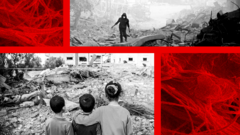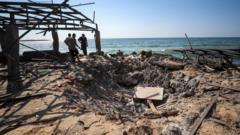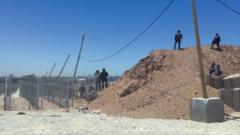The ongoing conflict in Gaza not only devastates lives but also unleashes long-term health threats, with asbestos contamination leading to increased risks of respiratory diseases and cancers.
Asbestos Threat Looms Over Gaza's War-Torn Rubble

Asbestos Threat Looms Over Gaza's War-Torn Rubble
The hidden dangers of asbestos contamination in Gaza's debris raise alarming health concerns for residents.
The aftermath of Israel's military assault on Gaza has turned the territory into a hazardous environment, laden with asbestos-riddled rubble. Once commonly used in construction, asbestos fibers, when disrupted, pose dire health risks as they can remain airborne and be easily inhaled, resulting in lung diseases such as asbestosis and mesothelioma. According to the United Nations Environment Programme (UNEP), an estimated 2.3 million tons of rubble in Gaza may contain this harmful material, generating significant concern among health experts. Notably, children are at risk of suffering lifelong consequences from exposure.
This situation is exacerbated by the dense population in Gaza, which hinders efforts to mitigate exposure to asbestos. Many residents are preoccupied with immediate survival amid ongoing military actions, overlooking the silent yet dangerous threat of airborne toxins. Medical professionals in the region express concerns over the lack of awareness surrounding asbestos risks and the inability of locals to prioritize such health threats when faced with daily life-and-death scenarios.
As the reconstruction of Gaza progresses, experts warn that the careful management of debris removal is crucial to prevent disturbing asbestos contamination. The clean-up efforts could take up to 21 years, with costs reaching $1.2 billion. Meanwhile, stark comparisons are drawn with other global incidents such as the 9/11 attacks, which revealed the devastating health effects of dust contamination on a civilian population. The complex nature of this crisis illustrates the urgent need for a comprehensive strategy to address both immediate and long-term health threats to Gaza’s inhabitants.
This situation is exacerbated by the dense population in Gaza, which hinders efforts to mitigate exposure to asbestos. Many residents are preoccupied with immediate survival amid ongoing military actions, overlooking the silent yet dangerous threat of airborne toxins. Medical professionals in the region express concerns over the lack of awareness surrounding asbestos risks and the inability of locals to prioritize such health threats when faced with daily life-and-death scenarios.
As the reconstruction of Gaza progresses, experts warn that the careful management of debris removal is crucial to prevent disturbing asbestos contamination. The clean-up efforts could take up to 21 years, with costs reaching $1.2 billion. Meanwhile, stark comparisons are drawn with other global incidents such as the 9/11 attacks, which revealed the devastating health effects of dust contamination on a civilian population. The complex nature of this crisis illustrates the urgent need for a comprehensive strategy to address both immediate and long-term health threats to Gaza’s inhabitants.


















